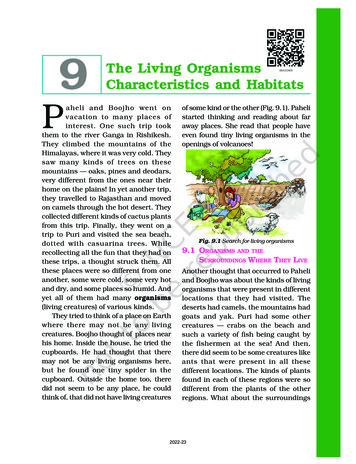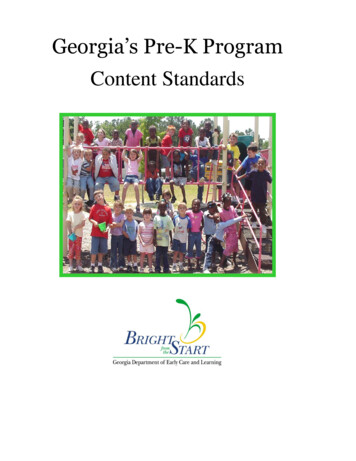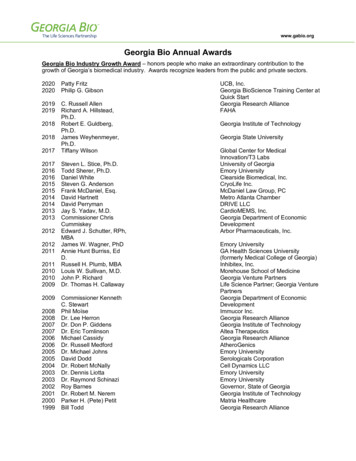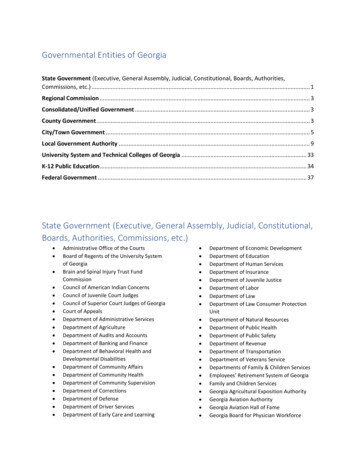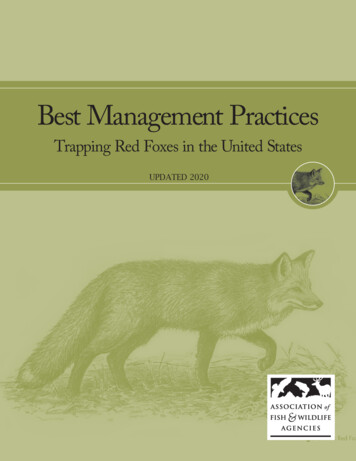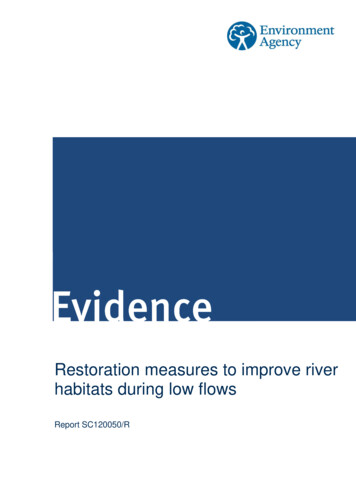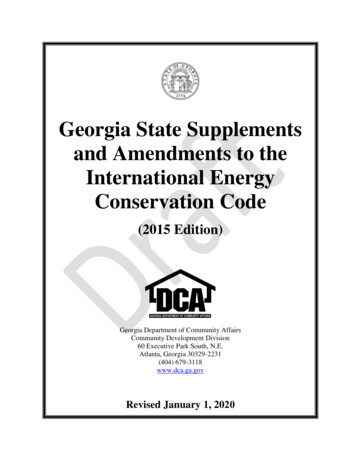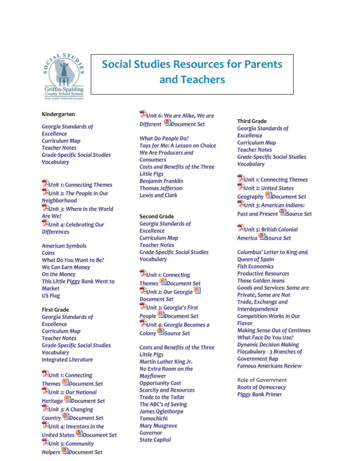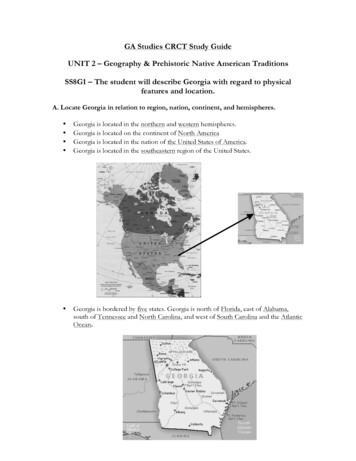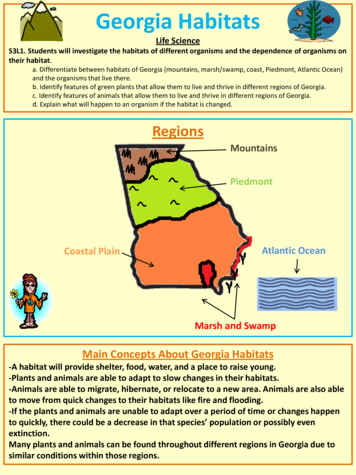
Transcription
Georgia HabitatsLife ScienceS3L1. Students will investigate the habitats of different organisms and the dependence of organisms ontheir habitat.a. Differentiate between habitats of Georgia (mountains, marsh/swamp, coast, Piedmont, Atlantic Ocean)and the organisms that live there.b. Identify features of green plants that allow them to live and thrive in different regions of Georgia.c. Identify features of animals that allow them to live and thrive in different regions of Georgia.d. Explain what will happen to an organism if the habitat is changed.RegionsMountainsPiedmontCoastal PlainAtlantic OceanMarsh and SwampMain Concepts About Georgia Habitats-A habitat will provide shelter, food, water, and a place to raise young.-Plants and animals are able to adapt to slow changes in their habitats.-Animals are able to migrate, hibernate, or relocate to a new area. Animals are also ableto move from quick changes to their habitats like fire and flooding.-If the plants and animals are unable to adapt over a period of time or changes happento quickly, there could be a decrease in that species’ population or possibly evenextinction.Many plants and animals can be found throughout different regions in Georgia due tosimilar conditions within those regions.
VocabularyHabitat - the living environment of animals and plants. A habitat provides a food/watersupply, shelter, and a place to raise young.Environment - everything that is around a living thing.Ecosystem - all the living and nonliving things that interact in a place.Adaptation - a process that helps living objects to survive in its’ environment.The 2 types of adaptations are PHYSICAL (appearance) and BEHAVIORAL (doing things).Mimicry – being able to resemble another animal or object.Survive - the ability to stay alive.Trait - a characteristic, or feature, of a living object.Organism - any living thing.Hibernate - to be in a deep sleep for a long period of time.Migrate - to travel from one place to another and back again for survival.Reproduce - to produce new living things.Food chain - an illustration that shows how energy is passed from one living thing toanother.Food web - an illustration that shows how animals are connected in their search for foodwithin an ecosystem.Producers -are plants that are able to make their own energy (food). (plants)Consumers are not able to produce their own energy (food). They depend on plants oranimals for food. (lions, dogs, humans, etc.)Decomposers get their energy by breaking down and absorbing dead organic matter.(mushrooms, bacteria, worms, buzzards)TYPES OF CONSUMERS:Carnivore- meat eatersHerbivore- plant eatersOmnivore- eats plants and meat
Mountain Region Characteristics: Blue Ridge mountain range of the Appalachian MountainsBrasstown Bald- the highest elevation in GeorgiaFresh, cool , flowing streams and riversOnly plants and animals that can survive colder weather and higher winds are foundhere. (Deer, wild turkey, black bear, birds (with curved beaks to find/eat seeds and shortclaws to hold on to branches), bats, salamanders, lizards, snakes, frogs, bobcats, grayfoxes, beavers, wood chucks, and trout) Upper mountain area: Cool and windy climate at higher elevations (thinner air less oxygen) Rocky, thin soil due to weathering and erosion Grasses and flowers grow better in this area Lower mountain area: Warmer neat the bottom of the mountain Less rocks and deeper, fertile (nutrient rich) soil due to humus Trees and shrubs (bushes) grow better in this area (Hardwood forest (maple,oak, magnolia, mountain laurel, and hickory)Piedmont Region Characteristics: Piedmont means “foothills”Low, rolling hills and plainsRed clay soil (due to the mineral iron)Pine trees (soft wood) and hardwood forest (oak and hickory)Lakes and muddy, slow moving rivers, and waterfallsMost populated area of Georgia (Atlanta is located in this region.)Rock outcrops (granite, marble, and quartz)The southern boundary is made up from the “fall line” (area of waterfalls and rapids)River otters, opossums, beavers, raccoons, squirrels, deer, birds and birds of prey (owls,hawks, eagles) Nocturnal animals that hunt for food at night and sleep during the day due to humanpopulation Wild animals are being found where people live because their forests are being cutdown Warm summers and mild winters (very few days of freezing temperatures)
Coastal Plains Region Characteristics: The largest habitat region in Georgia that was previously below sea level Richmond Hill and Savannah are located in this region Georgia’s land that is nearest the ocean Wide and flat land that is made of a sandy loam soil that is great for agriculture (growing food) Summers are hot and winters are mild Wild hogs, rabbits, deer, snakes, squirrels, turtles, alligators, & pocket gopher (near extinction) Water birds will be found near the coast or near rivers and large lakes/ponds Live oak and pine trees, Spanish moss, and a large variety of plantsSwamp and Marsh Region Characteristics: The Swamp and Marsh Region are located in the Coastal Plains. Summers are hot and winters are mild There are more alligators in this area than there are peopleSwamps: Okefenokee Swamp –”Land of Trembling Earth” (Fresh water swamp) Still, pure, clean, shallow water even though it appears dirty Shaded, soft, wet land with a nutrient poor quality of soil (little nutrients) When plants die, layers of “peat” are built up Prairies- open area with shallow water and tall grass where most of the animals live Lakes and islands Giant tupelo and bald cypress hammocks (clusters of wide based trees), pitcher plant,sundew, and bladderworts (insect eaters) Alligators, snakes, lizards, turtles and frogs live here- they are able to survive theconstantly changing water levels Black bears, deer, fox, bobcats, and raccoons Ducks and other birds with long pointed beaks to help spear fish (herons, kingfishers,cranes, and the white ibis)Marshes: have salty, tidal water (changes levels based on tides) Cord grass Estuaries- Breeding area and home for fish, crab, clams, oysters and shrimp (our seafoodsupply)
Coast and Atlantic Ocean: Located directly off of the coastal beaches of Georgia Plants that can tolerate salt and be grown in sand: sea oats , morning glory, cord grass,and cabbage palms Phytoplankton- important “producers” in this habitat- are the base of the ocean foodchain Saltwater- based habitat that allows fish, seaweed, plankton, sea turtles, and other seaorganisms to live. Summers are hot and winters are mild Manatees, right whales (endangered species), loggerhead sea turtles, and dolphins Seagulls (some sea birds can drink seawater by getting rid of the extra salt through theirnoses) Home for fish, crab, clams, oysters and shrimp (our seafood supply)
Vocabulary Habitat - the living environment of animals and plants.A habitat provides a food/water supply, shelter, and a place to raise young. Environment - everything that is around a living thing. Ecosystem - all the living and nonliving things that interact in a place. Adaptation - a process that helps living objects to survive in its' environment.
